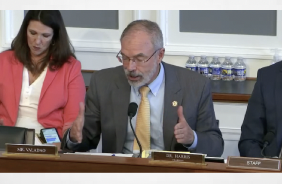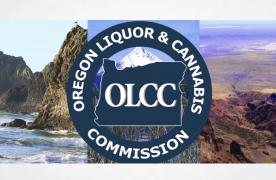If you wish to re-publish this story please do so with following accreditation
We quoted Lori Ajax in a recent article. We will repeat the quote,
“I just want to crush the illegal market,” Ajax said to applause at Meadowlands. “I don’t usually say that out loud …We didn’t go through this the last few years to have (the legal) market be undermined.”
California’s cannabis regulatory agencies have forgotten the story everyone was told many times as a child about the need for both a stick and a carrot to make a donkey work.
The donkey [“Jack Ass”] must be offered both. The leaders of California’s cannabis regulatory agencies forgot the entire story. The agencies have a big stick, but a huge carrot, as well as a good sales job, were required to sell California’s underground cannabis industry on becoming legal. California’s regulatory agencies, unfortunately, forgot about both the carrot and the sales job.
President Reagan had a big stick – the United States Marines. It was not big enough to crush California’s underground cannabis industry.
Lori Ajax has a big stick.
The Anza Valley eradication involved 700 law-enforcement and other personnel. This eradication cost millions of dollars. No doubt the raid made a little dent in California’s underground cannabis industry. A “Whack a mole!” approach to crushing the illegal market will have minimal impact in the long term. Enforcement alone will not be sufficient.
Can anything be done? If the agencies in California that regulate cannabis seriously concentrated on solutions, the state of the industry would substantially improve.
Lori Ajax, the Chief of the Bureau of Cannabis Control (“BCC”), has the power to cause such change. Business and Professions Code (“B&P”) §26010.5 (d) expressly tasks BCC with the “power, duty, purpose, responsibility, and jurisdiction to regulate” California’s commercial cannabis industry. BCC is the lead agency of the cannabis regulatory agencies. BCC is at the top of the pyramid. But BCC has failed to exercise its power and responsibility to regulate thoughtfully and judiciously.
All of California’s cannabis regulatory agencies, including BCC, overlooked the necessity to both present and sell regulation to the underground cannabis industry. BCC is not the regulatory agency that has most contributed to California’s booming underground cannabis market. CalCannabis, which is a Division of the California Department of Food and Agriculture (“CDFA”), takes first prize as the agency that made the most significant contribution to the explosion of the underground market. One could offer a strong argument CalCannabis is the principal reason California’s underground market is booming.
California’s underground market is not booming for the lack of a big stick. The Anza Valley eradication demonstrates the regulatory agencies have plenty of big sticks. There is also a giant carrot. The carrot is obvious. Money is flowing into California’s cannabis industry from all over the world. Why is cash flowing into California’s cannabis industry? People with money believe there is money to be made. The big stick is there. The big carrot is there. Why isn’t regulation working California?
The knee-jerk answer is that more money can be made more quickly in the underground cannabis market. Substantial amounts of money is being made in both the legal and the underground cannabis markets. The underground cannabis market is not more profitable than the legal market in the long-term if the additional costs, as well as the risks associated with illegality, are taken into account. Well-advised legal cannabis businesses will produce far more significant financial rewards in the long-term than underground companies.
Regulation is not working in California because BCC misunderstood its task. CalCannabis is the clearest illustration of a misconception of an agency’s responsibility, although BCC’s failure concerning the licensing of dispensaries is comparable to CalCannabis’ failure in connection with the licensing of cultivation. We identified CalCannabis as the regulatory agency that bears the most significant responsibility for the booming underground market based on the number of businesses injured. CalCannabis has caused damage to more cannabis businesses than any other agency by an order of magnitude.
One could point to CalCannabis as the principal cause of the Anza Valley eradication. However, BCC is responsible. The Legislature tasked BCC with the “power, duty [and] responsibility” to regulate commercial cannabis activity. CalCannabis was delegated the authority for the licensing of cultivation. CalCannabis was not delegated responsibility for regulating cultivation. CalCannabis failed abysmally in licensing because it undertook the task of regulating. BCC is responsible for CalCannabis’ failure at licensing because it failed to adequately supervise. The Legislature placed responsibility for the regulation of commercial cannabis on the BCC. BCC failed to perform.
CalCannabis had a simple regulatory task. As is noted above, CalCannabis is a Division of CDFA. CDFA is one of California’s most significant administrative agencies. CDFA has decades of experience regulating agriculture in California. How did CalCannabis go wrong? Why did CalCannabis fail so abysmally? The answer is quite simple. Neither CDFA nor BCC provided proper guidance to CalCannabis. Neither required CalCannabis to focus on the assigned task of licensing. BCC is responsible for this failure. BCC failed to provide the leadership and guidance required to prevent CalCannabis from failing.
The number of cannabis growers that CalCannabis was expected to license in a limited period made its task a severe challenge. California had thousands of cannabis growers before the passage of Proposition 64 and the enactment of the Medical and Adult Use Cannabis Regulation and Safety Act (“MAUCRSA”). Two aspects of the licensing of growers, however, gave CalCannabis the foundation it needed for success. First and foremost, those growers who want to be legal are the growers that CalCannabis is responsible for licensing. Second, the regulatory aspects of cultivation primarily involve land use and public health and safety, which are primarily local concerns.
Unfortunately, CalCannabis appears to have done little right. The evolution of regulation in California created a two-tier system for regulation. Licensing is merely a part of the regulation process. CalCannabis failed to focus on the limited task it was assigned. The challenge that CalCannabis faces in its licensing of cultivation makes it imperative that the agency make it as easy as possible for cultivators to become licensed. CalCannabis instead made the licensing of growers difficult, cumbersome and costly.
The challenge facing CalCannabis mandated that it defer regulatory decisions to local jurisdictions to the maximum extent possible. CalCannabis had an opportunity to minimize the burden of a two-tier system by focusing on education regarding state-wide requirements for compliance and wholly deferring to local decisions to the maximum extent possible.
CalCannabis has no stick. CalCannabis did not offer the only carrot it had – ease in licensing. CalCannabis should not be surprised it failed. It offered little. BCC should not be surprised that CalCannabis failed abysmally. Has CalCannabis explained why it made licensing so difficult and costly? Has CalCannabis revealed why it did not focus on approval of cultivation at a local level? Has BCC ever asked CalCannabis why it appears to have made so many poor decisions relating to licensing? There may be good reasons for the actions of CalCannabis, but they are not apparent to us.
The legal foundation for the regulation of medical and adult-use cannabis in California is set forth in two amendments to the California Constitution – Proposition 215 and Proposition 64. The Legislature has the authority to implement these Constitutional mandates. The Legislature has a limited ability to modify the Constitutional mandates. The Legislature has greater authority concerning modifications relating to Proposition 64 than to Proposition 215.
After delaying legislative action for almost 20 years, the Legislature acted to regulate California’s medical cannabis industry shortly before the passage of Proposition 64. Following the passage of Proposition 64, the Legislature enacted the Medical and Adult Use Cannabis Regulation and Safety Act (“MAUCRSA”) to create an integrated regulatory structure for both medical and adult-use cannabis.
MAUCRSA established a structure of administrative agencies headed by BCC for the regulation of California’s cannabis industry. The Legislature believed this organizational structure was reasonable and rational. This structure of administrative agencies led by BCC has created chaos out of order. Why?

















